While store bought caramels are good, nothing is quite as comforting as soft, chewy, homemade caramels. They’re rich, buttery, and chewy in the best way, and once you try one, it’s hard to stop at just one. If you grew up with a grandma who made these every year, you already know. And if you didn’t? You’re about to start your own tradition.
Looking to make caramel sauce? Try this recipe for Sea Salt Caramel Sauce.

Why My Recipe
- Buttery, soft, chewy texture that melts in your mouth.
- Perfect for holiday gifting, with easy storage and freezer tips included.
- No candy thermometer needed! Use the old-school water test instead.
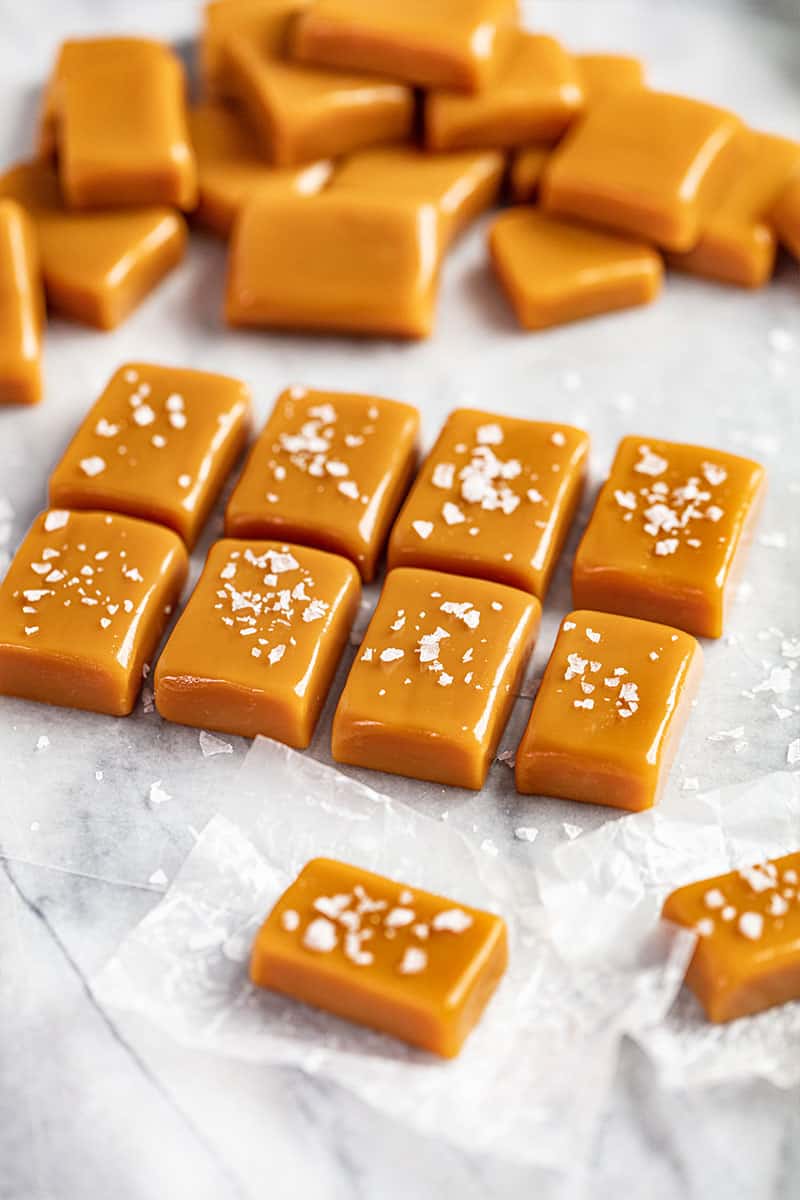
Every year at Christmas time, my grandma would make caramels and fudge. Her caramels were soft and chewy and absolutely perfect. This recipe takes me back to the good old days of spending a day off of school with family, and helping in the kitchen; frilly aprons on, flour and butter everywhere. If you’ve never experienced homemade caramels, this is a must-make recipe for you. Trust us, your life will never be the same.
Ingredient Notes
- Unsalted Butter: Use real butter, not margarine. This gives the caramels their rich, creamy flavor.
- Sweetened Condensed Milk: Be sure to use sweetened condensed milk, not evaporated milk—they are not interchangeable.
- Light Corn Syrup: Helps prevent crystallization for smooth, creamy caramels. You can substitute with 1 cup golden syrup or 1 cup homemade invert sugar.
- Brown Sugar: Use light brown sugar for a classic flavor, or dark brown sugar if you want a deeper molasses note.
- Vanilla Extract: Adds warmth and depth. Use real vanilla extract for best results.
- Salt: Just a small amount to balance the sweetness and enhance the caramel flavor.
Flavor Variations
Give your caramels a little flair with one of these variations.
Salted Variation: Sprinkle flaky sea salt on top once the caramel is poured but still warm. It gives a lovely contrast and highlights the buttery sweetness.
Vanilla Bean Upgrade: Use a vanilla bean (split‑and‑scraped) instead of extract for a richer vanilla flavor.
Chocolate Dipped: Once caramels are cut and cooled, dip one side in melted dark or milk chocolate. Let set on parchment. Adds richness and visual appeal.
Nutty Crunch: Fold in very finely chopped toasted pecans, almonds, or hazelnuts just before pouring into the pan for crunch and flavor.
Flavor Twists: Try infusing the butter or condensed milk with flavor like a pinch of espresso powder, orange zest, bourbon (if appropriate), or even a sprinkle of chili powder for a sweet heat finish.
Alternative Sugars: Substitute part of the brown sugar with dark brown sugar for a deeper molasses flavor; or use golden syrup / invert sugar to change color and texture slightly. Keep an eye on sweetness levels.
A Note on Corn Syrup
Corn syrup is an invert sugar. Invert sugars inhibit the formation of crystals (crystallization) giving you smooth and creamy caramels every time.
If you don’t have corn syrup or don’t want to use corn syrup, you can always make your own homemade invert sugar using sugar, water, and an acid (usually cream of tartar or citric acid). If you need to replace the corn syrup in this recipe, you’ll want to use another invert sugar that will also prevent crystallization, including:
- Honey (will impact flavor and won’t prevent crystalization as well)
- Golden Syrup
- Brown Rice Syrup
- Homemade Corn Syrup Substitute
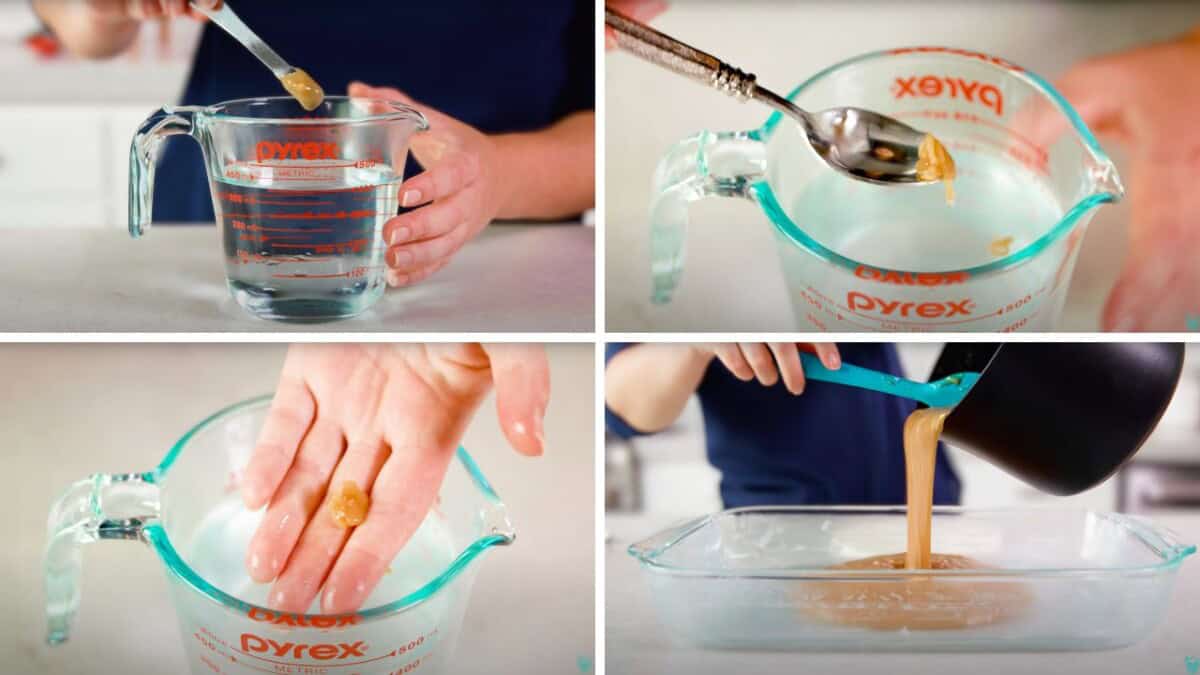
Candy Thermometer Tips
Using a candy thermometer takes the guesswork out of caramel making. You’re aiming for the soft-ball stage, which is between 235°F and 245°F.
Keep in mind that altitude affects boiling points. Use the lower end of the range if you live at a higher elevation.
No Candy Thermometer?
Don’t have a candy thermometer? Our grandparents didn’t either! You can determine if your caramel is ready the old fashioned way.
Fill a drinking glass or bowl with cold water. Add in just a drop of the caramel from the pan on the stove.
For the soft-ball stage, the caramel should form a small round ball in the cold water. When it is removed from the water, the caramel should flatten.
Elevation Adjustments
Because boiling points drop at higher elevations, your caramels will reach the soft-ball stage at a slightly lower temperature. Aim for around 235°F if you’re 3,000 feet or higher above sea level.
Troubleshooting Guide
While caramels are simple enough to make, there are still things that can go wrong. Many of them cannot be fixed once you’ve noticed an issue, but a troubleshooting guide can help you learn how to make them successfully in the future and perfect your caramel-making skills.
Cause: Sugar crystallization has occurred. This can happen if sugar wasn’t fully dissolved, or if sugar crystals were splashed onto the sides of the pan, or stirring was too aggressive at high heat.
How to Fix It: Wipe down the sides of the pan with a wet pastry brush during cooking; use corn syrup (or another invert sugar); ensure all sugar is dissolved before boil; avoid vigorous stirring once boiling starts.
Cause: Didn’t cook to high enough temperature (soft‑ball stage), or cooled too slowly, or pan was shallow so evaporation insufficient.
How to Fix It: Make sure caramel reaches the right temp (or passes water test), use thermometer if unsure; cook slightly longer but watch carefully; cool in a cooler place; use correct pan size.
Note, you cannot re-cook your caramel once it’s placed into the pan to start cooling.
Cause: Likely cooked beyond the soft‑ball stage; maybe temperature was too high or sugar cooked too long.
How to Fix It: Pull off heat sooner, especially if using thermometer; test with cold water drop often; adjust cooking time for elevation.
Cause: Sugar has over‑caramelized or burnt; heat too high or left cooking too long.
How to Fix It: Reduce heat in future; remove from heat once desired color/flavor reached; remember residual heat continues cooking; use light brown sugar / less intense cooking.
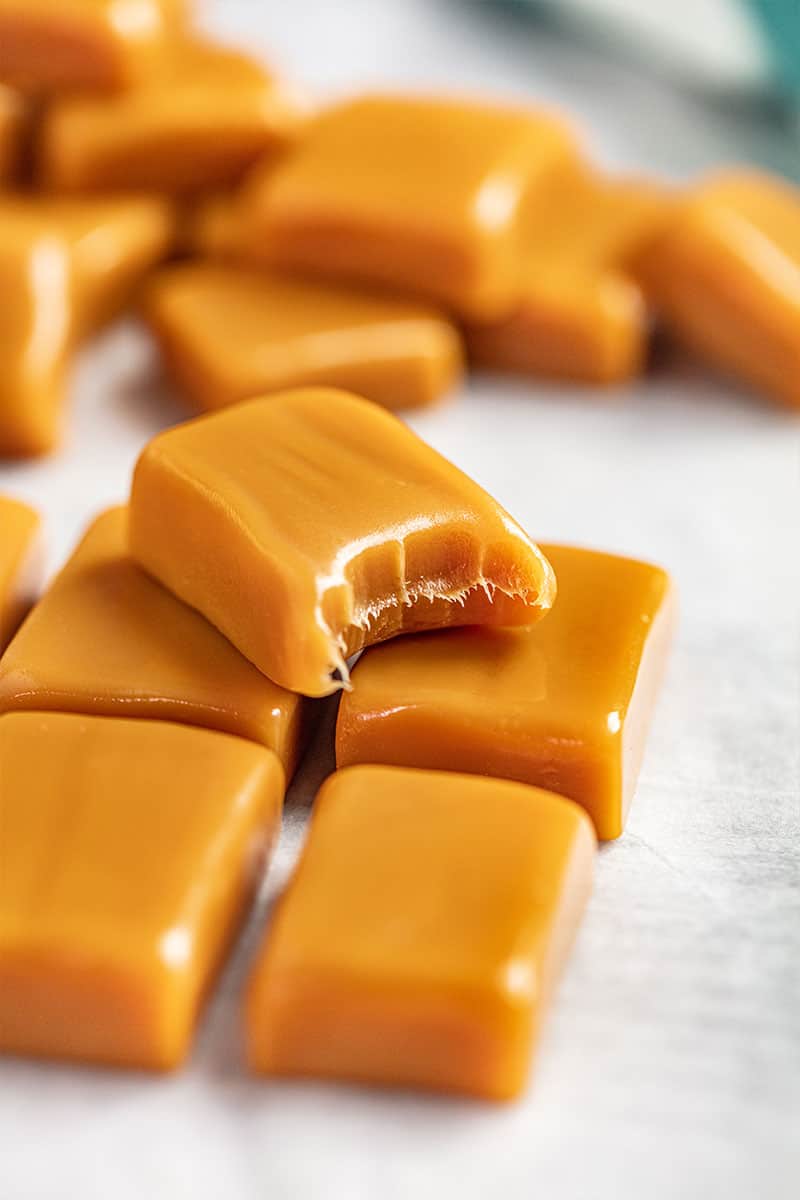
Cutting and Wrapping Caramels
Let your caramels cool completely before cutting. A buttered or greased sharp knife works best.
For wrapping, wax paper is your friend. Cut it into squares, wrap each caramel, and twist the ends. They’ll look just like the store-bought kind, they’ll just taste better.
Packaging, Gifting, & Shipping
Wrap each caramel square individually in wax paper or parchment paper to prevent sticking. Twist the ends or fold edges for a classic look.
Store wrapped caramels in a rigid box with parchment paper layers in between, especially if transporting. This helps prevent squishing or sticking.
If gifting in warm weather or for shipping, add a cold pack or heat‑resistant wrapping. Keep the caramels in a cooler part of the package.
Use airtight containers if keeping at home; humidity and heat soften caramels faster. For gifting, keep the package sealed until just before giving.
Include a note for recipients: “Store at room temperature, keep away from heat/humidity, unwrap individually for best texture.”
For long‑distance shipping: use insulated packaging, minimal headspace (so items don’t shift), and overnight or fast delivery when possible. Seasonal heat can cause caramels to soften or melt.
Storage Instructions
Once your caramels are wrapped in wax paper, they should last approximately 2 weeks at room temperature if stored in a ziptop bag or airtight canister. If you made a large batch, store wrapped caramels in a freezer safe bag to freeze for up to 6 months. Allow time to thaw completely before eating.
More Caramel Goodness…
Watch the video below where Rachel will walk you through every step of this recipe. Sometimes it helps to have a visual, and we’ve always got you covered with our cooking show. You can find the complete collection of recipes on YouTube, our Facebook Page, or right here on our website with their corresponding recipes.
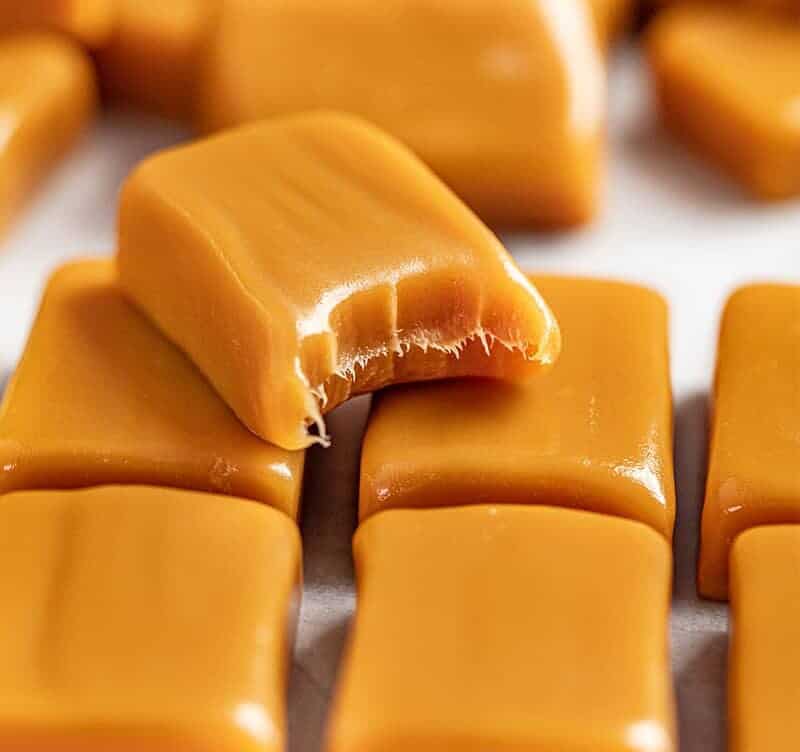
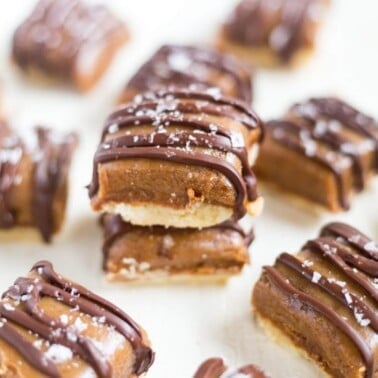
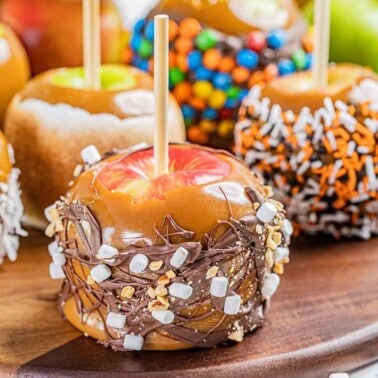
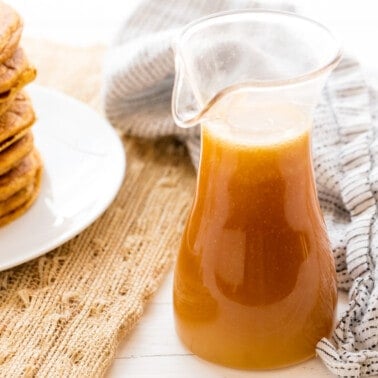
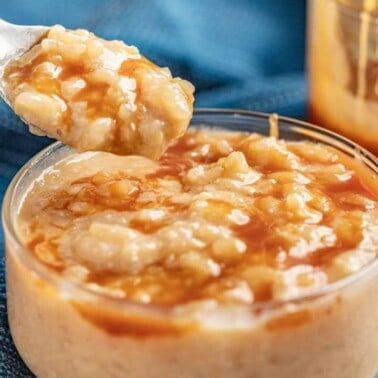
I am going to try this right now! Hope it turns out good. Stay tuned for how it turns out!
Hope it turns out great for you!
How do I make this recipe into Carmel sauce?
You’d want to use this recipe instead: https://thestayathomechef.com/sea-salt-caramel-sauce/
Made these today…OMG they are delicious thinking of adding pecans next time. Found a new item for Christmas baking.
Absolutely perfection!!! This recipe was so precise and easy to make. Caramel turned out buttery, creamy, smooth, sweet and a bit salty with added sea salt flakes on top. I dont know how many squares I cut them in to…but it was MANY! Im keeping them wrapped in wax paper, in a zip lock, in the fridge and they are still perfectly soft, chewy, but not too sticky! Will definitely make again! Thank you for sharing the recipe and the tips!
Can this recipe be used to make caramel apples ⁉️
It’s close, but this is the recipe you’ll want to follow for caramel apples: https://thestayathomechef.com/caramel-apples/
I specifically chose this recipe because it had clear instructions and advice. I live by the ocean so the temperature tip was very welcome. I brought my caramel to just under 240 degrees and it is as hard as a rock. I’m very disappointed since my family loves soft caramel not hard. The flavor is good but the texture is not. I’m not sure if I can even give them away.
Oh no, I’m so sorry that happened! Living by the ocean definitely makes candy-making trickier since the humidity and even altitude can affect how sugar sets. If your caramel turned out rock-hard at just under 240°F, there’s a few possibilities. It is possible that your thermometer might be reading a little high. Even a few degrees off can make a huge difference with caramel. For soft, chewy caramel, it’s usually perfect right around the firm ball stage (237–240°F on a calibrated thermometer), but if yours hardens too much, try stopping closer to 235°F.
Unfortunately, once it sets hard, there’s not really a way to soften it back up. But you could break it up and use it in other desserts, like sprinkling over brownies or melting it with a little cream to make a caramel sauce. At least the flavor’s good, so it doesn’t have to go to waste!
On YouTube someone crushed store bought hard caramels and mixed them with turbinado sugar and gave away as gifts OS finishing sugar 🙂
I just wanted to thank you so much for sharing your recipes with us. I have made several of your recipes and they were delicious. I am addicted to your Carmel popcorn recipe, I have shared the popcorn with my neighbors and they too loved it and was asking for more. So this is just a big thank you for all you do!!! Can’t wait to try more. Thanks bunches.
You are so welcome! Thank you for such kind words!
This recipe is easy to.follow and it.always turns out perfect for me.Love it!!!
Can’t wait to try 😋 this home made caramel ! I really enjoy soft caramels !
Let me know how it goes!